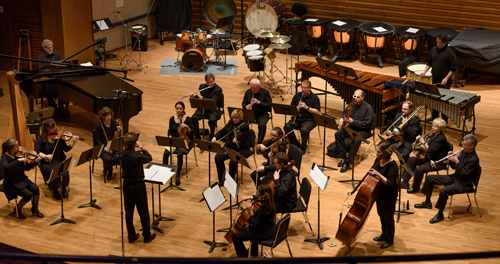by Mike Telin

Programming three first-time-ever performances of three works is a risk. However CCS and the Festival scored a hat trick: all of the works were musically inventive, aurally engaging and stylistically individual.
Conductor Steven Smith started things off with a straightforward account of Hymn and Fuguing Tune no. 10 for oboe and strings by American composer Henry Cowell. Smith drew a full-bodied sound from the stings, while oboist David McGuire’s expressive pastoral melodic lines sang lyrically above.
Jeremy Allen’s Once More Before We Part was a perfect musical follow-up to the Cowell, for it too is based on a hymn and also includes an extensive oboe solo midway through. But that is where comparisons between the two pieces end, for Allen has his own voice as a composer. Scored for flute, oboe, clarinet, bassoon, horn, trumpet, trombone, piano, percussion and strings and lasting less than ten minutes, the work’s melodic material is based on Allen’s own Celtic-inspired hymn tune. Beginning with soft sustained harmonics in the violas and cellos, punctuated with short chords from the winds and vibraphone, the piece transitions into a folksong-like section with repeated chords in a minimalist style. Smith correctly asked oboist McGuire to stand and take the lead during his extended quasi-cadenza. After a dynamically building tutti section, everything comes to a halt. Concertmaster Susan Britton’s warm solo evolved into a held chord, eventually bringing the charming, well-constructed piece to conclusion.
Steven Smith’s Chromo-Synchrony is a work that engages the listener from the very beginning. The ten-minute piece, scored for flute, oboe, clarinet, bassoon, horn, trumpet, harp, percussion and strings, opens with a fast rhythmic section that really catches the ear. Following a slow section, bouncing short notes lead to an everybody-gets-a solo period, all of which are inventive and full of quirky mood changes. Between each solo, a funky theme complete with numerous percussion instruments is presented. Following a short coda, the piece builds sonically until the end. Smith led a very tight performance of his rhythmically tricky piece.
The second half of the concert was devoted to a single work, Clint Needham’s Imaginary Dances (Made Visible) with choreography by Sara Whale performed by Verb Ballets. 20 minutes in duration, the work is scored for single winds and brass (except tuba), two violins and one viola, cello and bass as well as piano and trap set with percussion and electronics. Needham also includes auxiliary instruments: piccolo, bass clarinet and piccolo trumpet.
In his composer’s statement, Needham points out that the music can be performed as a concert work, but each of the distinct musical sections was written with movement in mind. This last statement was in evidence from the beginning of the work. Although there is no stated story behind Whale’s choreography, Needham, through the use of diverse musical influences, has brilliantly provided her with the opportunity to have each of those sections become its own short story. Her choreography accomplished this with aplomb.
After a thunderous opening chord, the music continues with a series of single-note pulses. Each new musical section is preceded by electronic air sounds over which individual players have extended solos— first the violin, second the flute, third, the trumpet. Following each solo a new musical tutti section occurs, one lyrical, one jazzy, and one where the jazz motive is more fully developed. After that, the piece quickly transitions into a coda section that builds, rapidly bringing the piece to a fitting conclusion.
Costumed in black suits and shirts for the men and black spaghetti-strapped dresses for the women, the eight Verb Ballets dancers were superb. Whale’s choreography consisted almost entirely of unison movement, but each member of the company was up to the task — every ensemble section was performed as if it were a single physical unit. Whale also proved plenty of opportunity for solos as well, each of which was executed with graceful elasticity. In fact, the chorography centered around two styles: graceful extended movements, and short jerky motions. Something in between — just once — would have added a nice touch. That said, this was a magical marriage of music and dance that deserves to have second, third and fourth performances. Hopefully that will be able to happen.
Photos by Bill Naiman.
Published on ClevelandClassical.com March 31, 2015.
Click here for a printable copy of this article



